
National Handloom Day 2024: From Baluchari to Rangkaat, 5 lesser known crafts and textile traditions of India
8 months ago | 127 Views
National Handloom Day is celebrated every year on August 7 to honour the nation's handloom weavers and to shed spotlight on India's handloom industry. In the grand tapestry of fashion, where trends shift like the sands of time, certain threads remain eternally elegant. Yet, amidst the whirlwind of contemporary styles, some of these exquisite weaves risk being relegated to the back of our wardrobes. This Handloom Day, let us rediscover the enchantment of these forgotten masterpieces. Anindita Sardar, Head of Design and Curation at Taneira, shared with HT Lifestyle some lesser-known crafts and textile traditions of India.
Brilliant Baluchari

Renowned for its distinctive aesthetic, the Baluchari saree is a masterpiece of Bengali craftsmanship. Adorned with intricate depictions of ancient epics, mythology, and folklore, its weave embodies a rich tapestry of cultural heritage and storytelling. Characterised by vibrant colours and elaborate craftsmanship, the saree features an elongated pallu embellished with meticulously framed rectangular motifs, often showcasing mythological figurines as part of its motif language. Frequently hailed among the 'most stunning silk sarees in India', Balucharis are celebrated for their refined resplendence.
Resplendent Rangkaat
Banarasi Rangkaat is a gem among lesser-known Indian textiles. Adorned with sona-rupa zari in a soft, vibrant spectrum of colours, it epitomises sophistication. Woven uses an elaborate tapestry technique, and each piece takes three to four months, with two skilled weavers working in harmony. The intricate weaving technique interlocks different coloured patterns to create a mesmerising surface, greatly enhancing its visual appeal. Zari tissue lines often add an extra touch of opulence, creating a shimmering effect that captures the essence of luxury. This painstaking craftsmanship makes Banarasi Rangkaat not just a saree but a wearable work of art.
Vibrant Vairoosi
Vairaoosi, translating to "diamond needles" is an essential piece in every Kanjeevaram saree collection. This classic saree is crafted from pure zari, creating fine, intricate zari lines on the warp that shimmer like tiny diamonds when worn. Owning a Vairaoosi Kanjeevaram is not just about fashion; it's about preserving a piece of India's rich textile heritage.
Dazzling Doli Barat
This auspicious Chanderi saree is no ordinary stunner. Crafted from pure silk, it's a luxurious piece that feels like a gentle embrace. Unlike the usual Chanderi, this beauty boasts intricate jacquard borders that are like miniature masterpieces. The borders are garnished with a grand wedding procession with the bride seated in a palanquin and the groom riding a majestic horse intricately woven into the fabric, telling a tale of love and tradition. Adorning a Doli Barat is akin to wearing a vibrant celebration.
Graceful Gyasar

Gyasar represents a harmonious confluence of Varanasi's weaving traditions and Tibet's ceremonial customs. Originating in Varanasi on the banks of the Ganga, this exquisite weave is a stunning fusion of Buddhist artistry and Indian craftsmanship. The rich brocade is crafted by twisting three or four gold-coated silk threads into a single twine in the weft, creating bold floral patterns with striking textural designs. The silk floral motifs, etched in gold, epitomise the luxurious and intricate nature of Gyasar, making it a true masterpiece of cultural and artistic synthesis.
Read Also: National Handloom Day 2024: Mysore silk, Begumpuri, Kanjivaram to Chanderi, trending handloom sarees for your wardrobe



















